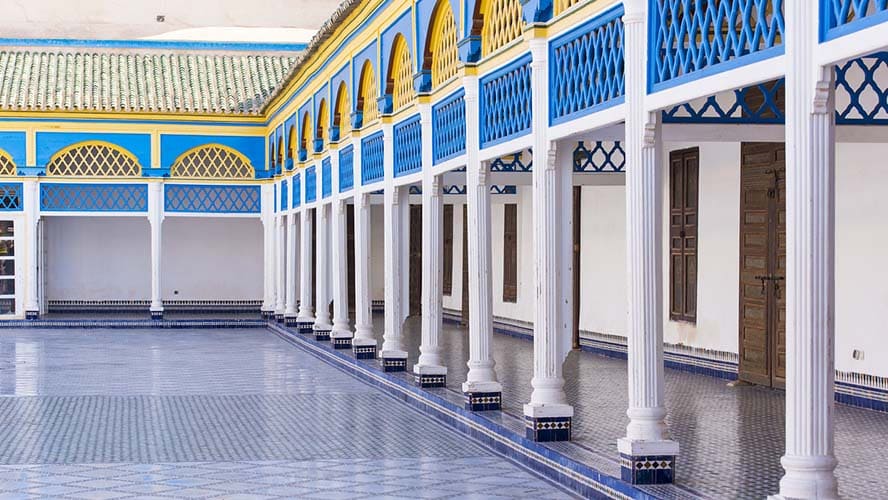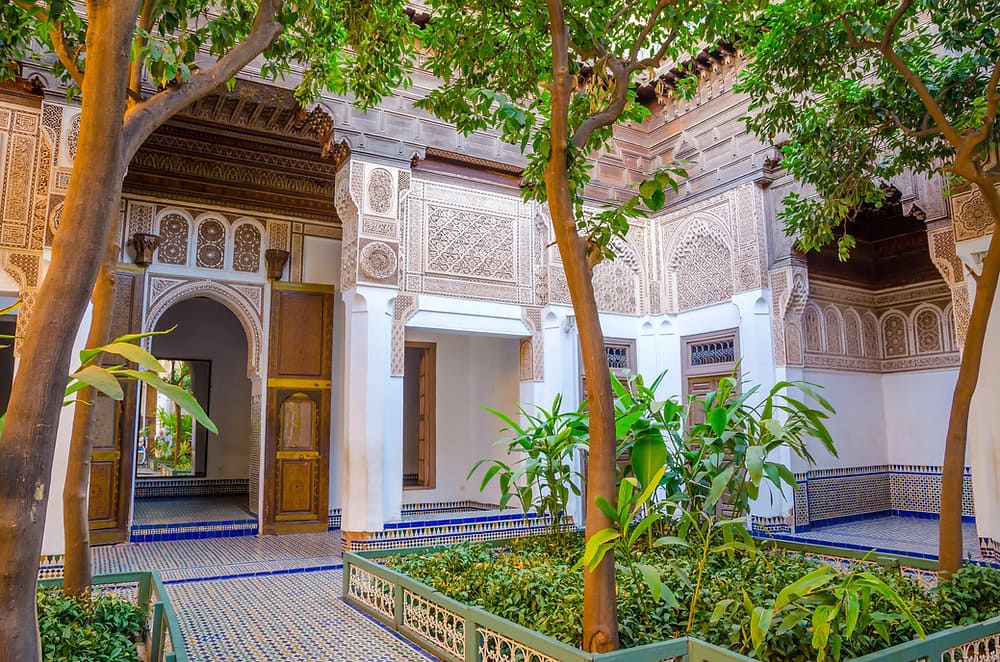The Bahia Palace, located in the heart of Marrakech, is an architectural gem that transports visitors to Morocco’s heyday. With its intricate designs, extensive gardens and serene courtyards, this palace is one of the city’s most prominent tourist destinations.
In this article, we will explore its history, architectural features and practical details for planning your visit.
History of the Bay Palace
The Bahia Palace was built at the end of the 19th century by the grand vizier Ahmed Ben Moussa, also known as Ba Ahmed. Designed to be a grand and luxurious residence, its name, “the Bay”, means “the brilliant” or “the beautiful”, in honor of his favorite of the harem.

The architect in charge of this work, Muhammad al-Mekki, worked for years to create a space that reflected the opulence and power of the vizier. Although it was not completed in its entirety, the result was one of the most impressive constructions of the time.
Structure and Design of the Palace
The Bahia Palace covers approximately eight hectares and combines elements of Islamic and Moroccan architecture. Its spaces are designed to offer privacy and comfort, adapting to the needs of the vizier and his harem.
- Courtyards and gardens: The palace has numerous interior courtyards decorated with mosaics and surrounded by ornate arches. One of the most outstanding is the central courtyard, where you can admire fountains and a symmetrical design that conveys serenity. The gardens, full of orange trees, palm trees and jasmine, provide a fresh and relaxing atmosphere.
- Private rooms: The harem rooms, designed in a more intimate style, are decorated with zelliges (traditional mosaics), carved wooden ceilings and gilded details.
- Reception room: Intended to receive important guests, this room shows the richness of the palace with its imposing decoration and spaciousness.
Riads: A Distinctive Element
A distinctive feature of the Bahia Palace is its riads, small traditional houses arranged around courtyards.

These spaces reflect the essence of Moroccan architecture, where life revolves around the tranquility and privacy of the central courtyard.
Location of the Bay Palace
The Bahia Palace is located in the medina of Marrakech, close to other iconic sites such as the Jemaa el-Fna Square and the El Badi Palace. Its central location makes it an ideal starting point for exploring the historic heart of the city.
Address: Rue de la Bahia, Marrakech.
Hours and Admission Price
The palace is open to the public almost every day, making it easy to include it in your itinerary.
- Hours: Monday to Sunday, 9:00 am to 5:00 pm. It is advisable to visit in the morning to avoid the crowds.
- Entrance fee: The entrance fee is approximately 70 dirhams (about 6.50 €). Children under 12 years of age usually have free access.
Visiting Tips
- Arrive early: The palace can fill up quickly, especially during peak seasons.
- Guided tour: Opting for a local guide will enrich your experience as you learn about the historical and architectural details of the place.
- Explore the surroundings: Take advantage of the proximity to discover other points of interest in the medina, such as the souks and the Saadian tombs.
Discover Marrakech and Beyond
The Bahia Palace is just one of the many treasures that Marrakech has to offer. If you wish to explore this city and much more, the Morocco 5 days tour from Marrakech to Fez is an excellent choice.
This tour will take you to discover the charms of Marrakech, the majesty of Casablanca, and the historic medinas of Fez, combining adventure and culture in an unforgettable experience.
Conclusion
The Bahia Palace is a must-see for those who wish to immerse themselves in the history and art of Marrakech. Its serene courtyards, lush gardens and architectural details make this place an exceptional example of Moroccan heritage.
Whether you explore its nooks and crannies on foot or marvel at the mosaics and carved ceilings, the Bahia Palace offers a unique experience. Don’t miss the opportunity to include it in your itinerary, and if you’re looking for a broader adventure, consider a tour that allows you to discover Morocco’s secrets in depth – a journey full of culture, history and beauty awaits!



